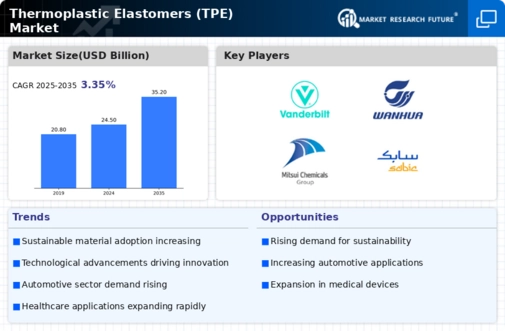Top Industry Leaders in the Thermoplastic Elastomers Market

Thermoplastic elastomers (TPEs), those magical materials combining the elasticity of rubber with the processing ease of thermoplastics, are silently shaping our world, attracting an array of players vying for a slice of the stretchy pie. Let's unravel the intricacies of the TPE market, examining key strategies, market share influencers, industry news, and recent developments.
Strategies Adopted by Market Leaders:
-
Product Innovation: The game is all about pushing boundaries. Companies like Dow Chemical are developing TPEs with exceptional temperature resistance, like DURATHAN®, catering to demanding automotive applications. Meanwhile, Kraiburg TPE expands its portfolio with bio-based options like THERMEX® ECO, addressing sustainability concerns. -
Diversification: Beyond traditional segments like footwear and medical devices, TPEs are finding new homes. Kraton Polymers, with its CARIFLEX® series, targets the booming construction market, while BASF ventures into high-performance TPEs for the oil and gas industry with its Elastollan® range. -
Technological Advancements: Nanotechnology and new processing techniques are unlocking unique possibilities. Covestro, with its MAXXESS® technology, offers TPEs with improved surface properties and adhesion, while DSM leverages advanced co-extrusion techniques to create multi-layered TPEs with tailored functionalities. -
Strategic Partnerships and Acquisitions: Collaboration is key. 3M acquired HIT Adhesive Technologies in 2023, bolstering its expertise in hot-melt TPEs for automotive interiors. Meanwhile, Sika's acquisition of a leading Chinese silicone sealant manufacturer strengthens its reach in the Asia-Pacific market.
Factors Influencing Market Share:
-
End-use Industry Growth: TPEs thrive on growth in key industries like automotive, construction, and healthcare. Rising electric vehicle adoption and infrastructure spending bode well for the market. -
Regional Trends: Asia-Pacific is the growth engine, driven by its large and rapidly urbanizing population. Europe and North America remain significant, but face challenges from stricter regulations and mature industries. -
Sustainability Focus: Eco-conscious consumers and tightening regulations are pushing for bio-based and recyclable TPEs. Companies like Evonik are responding with their VESTA bio-based TPE portfolio. -
Pricing and Supply Chain: Cost-effectiveness and reliable supply chains are crucial. Vertical integration and online sales channels are being adopted to optimize pricing and reach customers effectively.
Key Players:
- Timco Rubber (US)
- Arkema (France)
- Huntsman International LLC (US)
- Dow Chemical Company (US)
- RTP Company (US)
- Covestro AG (Germany)
- Kraiburg TPE GmbH & Co. KG (Germany)
- Tosoh Corporation (Japan)
- Lubrizol Corporation (US)
- Teknor Apex (US)
- Kent Elastomer Products (US)
- Altana AG (Germany)
- JSR Corporation (Japan)
- Elastron Kimya SAN. TİC. AŞ (Turkey)
Recent Developments:
December 2023: 3M launches a new line of high-performance TPEs specifically designed for extreme temperature applications, targeting demanding industrial environments.
November 2023: Henkel announces the expansion of its production capacity for polyurethane TPEs in Europe to meet growing demand.
October 2023: Dow Chemical unveils a bio-based silicone TPE with properties comparable to traditional silicone TPEs, catering to the eco-conscious consumer.
September 2023: The European Adhesive and Sealant Industry Association (FEICA) releases a new industry standard for the classification of TPEs.
August 2023: Sika partners with a leading robotics company to develop automated TPE application systems for the construction industry, aiming to improve efficiency and safety.

